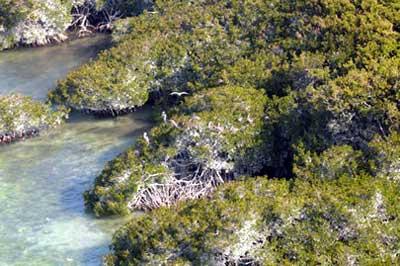Aircraft have been used effectively for many years as an efficient way to monitor wildlife and other resources in parks, but a staff member at Biscayne National Park wondered if there might be a better way. The end result of this "trial balloon" was a literal one – a flight in a blimp.
Matt Patterson, the South Florida/Caribbean Network Coordinator for the National Park Service, saw MetLife’s Snoopy One blimp in the air over southern Florida one day, and started wondering if a blimp might have advantages over the helicopters that are normally used for a variety of resource monitoring projects.
Helicopters are maneuverable but they're also noisy, and the strong downdraft winds are a potential problem for wildlife if a helicopter is operating at low altitudes. Might a blimp offer some advantages over traditional fixed or rotary wing aircraft for aerial monitoring?
It took a bit of work to obtain the necessary approvals, but on December 20th, two staff members from the NPS' South Florida/Caribbean Network overflew Biscayne National Park in MetLife’s Snoopy One blimp. The purpose of the trip was "to determine if the airship might prove as or more effective than a helicopter for aerial monitoring of park natural resources."
Matt Patterson and Kevin Whelan flew with Captain Mark Finney in Snoopy One, departing from North Perry Hollywood Airport around 9 a.m. after a pre-flight briefing, addition of helium, and fueling. They first flew out over the coast and evaluated visibility over the Atlantic Ocean. There was a marine fog layer, but it soon burned off and they continued south along Miami Beach and Key Biscayne and entered the north end of Biscayne National Park near Stiltsville.
One of the main purposes of the trip was to evaluate how colonial nesting bird activity might possibly change when approaching nesting/roosting birds by blimp compared with similar approaches by helicopter. "Generally, the helicopter noise and downdraft will spook some birds during the approach," Patterson said, "but most will circle and then land shortly afterward."
How did the birds react to the blimp?
According to Patterson, similar behavior was seen in double crested cormorants during the blimp’s approach, but in most cases they soon returned to the islands to roost.
Snoopy One flew to Soldier Key, circling twice, and then moved down the northern keys to Ragged 5, Sands, Elliott, Jones Lagoon, and the Arsenickers. While surveying Sands and Elliott Keys, the blimp circled slowly at low altitude (~250 feet) in hopes that the observers could identify potential Mexican red-bellied squirrel nests in the tree canopy. The squirrels are an exotic species in the park. Some nests were spotted, but this activity is more successfully seen in early spring after the mahogany trees have dropped their leaves.
The blimp continued south along the mainland towards the mouth of the Turkey Point nuclear power plant cooling canals, then turned north and headed across the middle of Biscayne Bay to Key Biscayne, along the beach, and back to North Perry Hollywood Airport.
During the trip, the observers documented several species of birds, including osprey, roseate spoonbills, great blue herons, anhinga, and double crested cormorants. They also saw manta rays, several sharks, dolphin, and manatees.
While in the air, a number of high resolution photos were taken by the park staffers. Once enlarged, the images can provide counts of birds by species and in some cases, even the numbers of active nests.
Patterson says that although the blimp isn't silent, it's less noisy than a helicopter. The larger craft has one key difference—a much larger shadow. One flight isn't enough to draw any firm conclusions about the pros and cons of airship use, but the park would like to use this platform again in the future if it were to be available.
Snoopy One is one of two airships in the MetLife Blimp Program. Snoopy One spends the winter and spring months in Florida, Georgia and Texas, while the companion ship spends the winter on the West Coast touring California, Nevada and Arizona.
According to the company, the primary focus of the blimp program is providing aerial coverage of sporting and special events. MetLife provided the use of the airship for last month's trip at no cost to the park.
Here's a good example of a "what if" idea by a park employee that literally got off the ground.




Add comment